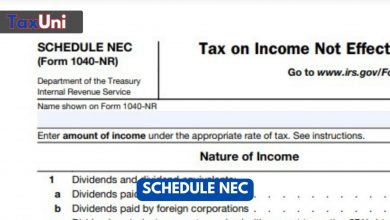Schedule 1 – AGI Tax Form
Contents
Schedule 1, Additional Income and Adjustments to Income, is a tax form that you must file with your federal income tax return. Filling out this tax form determines your adjusted gross income and reduces taxable income – well – in most cases.
There are two reasons to file Schedule 1. You fill it out to report additional income you earned during the tax year that isn’t reported on other tax forms and make adjustments to your total gross income.
This article will go over everything you need to know about Schedule 1 and provide you with the online fillable PDF version of the document so you can fill it out on your computer or tablet and print a paper copy.
What is additional income?
The additional income on Schedule 1 is the income you earned during the tax year but wasn’t reported on any tax form like 1099s. Since you must report your gross income in full on taxes, Schedule 1 is how you do it.
There are various types of income listed on Schedule 1, but if the kind of income you earned doesn’t fit any of the descriptions, you can list it yourself. Alimony payments received, farm income, business income, rental real estate property income, and many more are already on Schedule 1. Furthermore, simply enter the type of income earned and the money amount on Line 8(z) and calculate your gross income accordingly.
What is an adjustment to income?
The adjustments to income on Schedule 1 basically work the same way as deductions. The difference is that you can utilize these to reduce your taxable income even if you take the standard deduction. You don’t need to itemize to take advantage of these adjustments. The adjustments on Schedule 1 are also known as above-the-line deductions.
Fill out Schedule 1 2023 – 2024 online

Below, you can get Schedule 1 to use for the 2021 tax year, which you’ll file a federal income tax return for in 2022. After you complete it, enter your adjusted gross income on Form 1040 and attach Schedule 1.
What is AGI for taxes?
Now comes the crucial part – your adjusted gross income. This is separate from your taxable income, and you get this amount before any deductions. Most tax deductions that are a part of itemized deductions have an AGI limit. Use your adjusted gross income to determine your eligibility for tax deductions and credits.
Learn more about adjusted gross income.
AGI calculator
Calculating adjusted gross income is a two-step process. First, you calculate total gross income accounting for the additional income; then subtract the adjustments; in other words, above-the-line deductions. The result is your adjusted gross income.
FAQs
Where to use AGI?
Adjusted gross income isn’t only used for figuring out eligibility for certain tax deductions and credits. You also use this to verify your identity when e-filing taxes. The Internal Revenue Service requires taxpayers to enter the previous year’s adjusted gross income to verify their identity. That said, entering your Social Security number and other personal information isn’t it for confirming who you are. It’s best to note your AGI for every tax year as you’re likely to use it if you e-file the following year.
Is calculating AGI required?
Taxpayers must calculate their adjusted gross income even if they don’t have additional income or can’t claim any of the above-the-line deductions. If such a thing applies to you, enter your gross income as your adjusted gross income, but make sure to report any additional income you earned on Schedule 1 if you have to note.
Where is AGI on W-2?
Employers file Form W-2 to report wages, salaries, tips, and other compensation paid to employees. The purpose of Form W-2 is irrelevant to an employee’s adjusted gross income as it’s about Schedule 1. Don’t look for your adjusted gross income on the Form W-2 you received, as it won’t display such information, and you must calculate it yourself.





